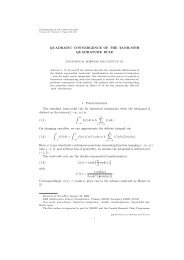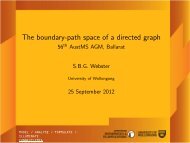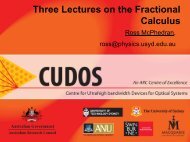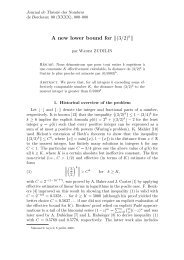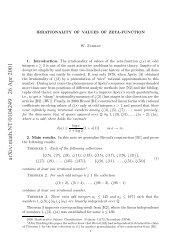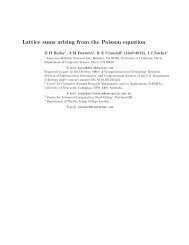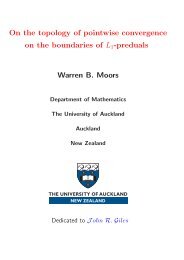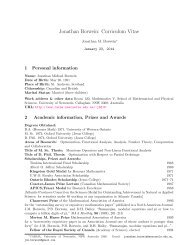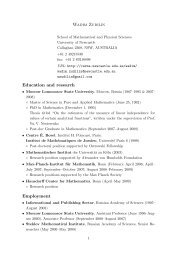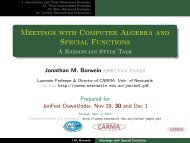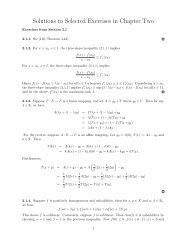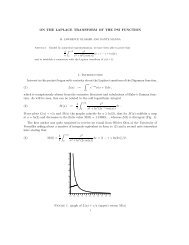PDF copy of the paper (210K). - School of Mathematics and Physics ...
PDF copy of the paper (210K). - School of Mathematics and Physics ...
PDF copy of the paper (210K). - School of Mathematics and Physics ...
Create successful ePaper yourself
Turn your PDF publications into a flip-book with our unique Google optimized e-Paper software.
Structure <strong>of</strong> Graph Posets for Orders 4 to 8Peter Adams ∗<strong>School</strong> <strong>of</strong> Physical SciencesThe University <strong>of</strong> Queensl<strong>and</strong>QLD 4072, AustraliaRoger B. EggletonMa<strong>the</strong>matics DepartmentIllinois State UniversityNormal, IL 61790-4520, USAJames A. MacDougall<strong>School</strong> <strong>of</strong> Ma<strong>the</strong>matical <strong>and</strong> Physical SciencesThe University <strong>of</strong> NewcastleNSW 2308, AustraliaAugust 13, 2004AbstractThe poset G(n) comprises <strong>the</strong> unlabelled simple graphs <strong>of</strong>order n, with partial ordering G ≤ H whenever G is a spanningsubgraph <strong>of</strong> H. We define a modified Steinbach numbering <strong>of</strong><strong>the</strong> graphs in G(n), apply this numbering to each G(n) withn ≤ 8, <strong>and</strong> use it to tabulate <strong>the</strong> Hasse diagram structure<strong>of</strong> <strong>the</strong> posets with 4 ≤ n ≤ 8 toge<strong>the</strong>r with key aspects <strong>of</strong><strong>the</strong> independence structure <strong>of</strong> <strong>the</strong>se posets. In particular, <strong>the</strong>Hasse diagram <strong>of</strong> G(8) is a directed graph <strong>of</strong> order 12346 <strong>and</strong>size 125066; <strong>the</strong> poset G(8) has 51952895 independent pairs <strong>of</strong>graphs, <strong>and</strong> 96775426396 independent triples. We present 14tables <strong>of</strong> descriptive data for G(n) with 4 ≤ n ≤ 8. All <strong>of</strong> <strong>the</strong>underlying data can be found on our webpagewww.maths.uq.edu.au/~pa/research/posets4to8.html2000 Ma<strong>the</strong>matics subject classification: primary 05C99,secondary 05C07, 06A07.∗ Research supported by <strong>the</strong> Australian Research Council1
1 IntroductionLet G(n) be <strong>the</strong> set <strong>of</strong> unlabelled simple graphs <strong>of</strong> order n, or “<strong>the</strong>set <strong>of</strong> graphs <strong>of</strong> order n” for simplicity. The set G(n) is a partiallyordered set (poset) under <strong>the</strong> relation G ≤ H, defined wheneverG, H ∈ G(n) <strong>and</strong> G is isomorphic to a subgraph <strong>of</strong> H. For convenience,we shall regard all graphs in G(n) as having <strong>the</strong> same vertexset, <strong>and</strong> so interpret G ≤ H as meaning that G is a spanning subgraph<strong>of</strong> H. Experience shows that using <strong>the</strong> set notation G(n) toalso denote <strong>the</strong> poset does not cause confusion, so we shall followthat practice. Since <strong>the</strong> graphs <strong>of</strong> small order are <strong>the</strong> fundamentalstructures <strong>of</strong> graph <strong>the</strong>ory, <strong>the</strong>ir structural relationships are <strong>of</strong> greatinterest. Motivated by this fact, our objective here is to present precisecomputational data on various structural characteristics <strong>of</strong> <strong>the</strong>posets G(n) for small values <strong>of</strong> n.The posets G(1), G(2) <strong>and</strong> G(3) have orders 1, 2 <strong>and</strong> 4 respectively,<strong>and</strong> each is linearly ordered, so <strong>the</strong>ir structure is completelytransparent. The first member <strong>of</strong> <strong>the</strong> family that is not linearlyordered is <strong>the</strong> poset G(4), <strong>of</strong> order 11. Subsequent members haveorders|G(5)| = 34, |G(6)| = 156, |G(7)| = 1044, |G(8)| = 12346, · · · .Indeed, <strong>the</strong> orders |G(n)| for n ≥ 1 are <strong>the</strong> terms <strong>of</strong> sequence A000088in Sloane’s Encyclopedia <strong>of</strong> Integer Sequences [5]. The structuralcomplexity <strong>of</strong> G(n) grows correspondingly rapidly, <strong>and</strong> propertieswhich are easily determined by inspection for G(4) may be computationallychallenging to determine for G(n) when n = 8, or evensooner.In each poset G(n), <strong>the</strong> complete graph K n is <strong>the</strong> unique maximalelement. The complement G c <strong>of</strong> any graph G ∈ G(n) is <strong>the</strong> graphG c := K n −E(G), where E(G) is <strong>the</strong> edge set <strong>of</strong> G. In particular, <strong>the</strong>empty graph Kn c is <strong>the</strong> unique minimal element <strong>of</strong> G(n). If G, H ∈G(n) <strong>and</strong> G ≤ H, <strong>the</strong>n H c ≤ G c , so <strong>the</strong> complementation mapc : G(n)→G(n), mapping each graph G to its complement G c , isan anti-automorphism <strong>of</strong> <strong>the</strong> poset G(n). Thus G(n) has a type <strong>of</strong>central symmetry.2
2 Numbering <strong>the</strong> graphs <strong>of</strong> order nTo discuss <strong>the</strong> poset structure <strong>of</strong> G(n) we must first have a method <strong>of</strong>specifying <strong>the</strong> graphs <strong>of</strong> order n. In his Field Guide to Simple Graphs[6], Steinbach illustrates every graph <strong>of</strong> order n ≤ 7 (a total <strong>of</strong> 1252graphs), <strong>and</strong> to each such graph G he assigns a number N(G), whichwe call <strong>the</strong> Steinbach number <strong>of</strong> G. With four exceptions, Steinbachnumbers satisfy <strong>the</strong> complementation ruleN(G) + N(G c ) = |G(n)| + 1,so a graph <strong>and</strong> its complement occupy complementary positionswithin <strong>the</strong> listing in [6]. Because Steinbach numbers reflect <strong>the</strong> antiautomorphism<strong>of</strong> G(n) produced by complementation, <strong>the</strong>y are wellsuited to our purposes. (In <strong>the</strong>ir Atlas <strong>of</strong> Graphs [4], Read <strong>and</strong> Wilsongive a different numbering system <strong>and</strong> set <strong>of</strong> illustrations for <strong>the</strong>members <strong>of</strong> G(n) with n ≤ 7, but <strong>the</strong>ir numbering has no simplerelationship with complementation, so is not as well suited to posetdescription.)For each n ≤ 7, Steinbach’s numbering <strong>of</strong> <strong>the</strong> graphs in G(n)first sorts <strong>the</strong>m by increasing size (number <strong>of</strong> edges). Once a graphG in <strong>the</strong> “first half” <strong>of</strong> G(n) has been assigned a Steinbach number,if G c ≠ G <strong>the</strong>n G c lies in <strong>the</strong> “second half” <strong>of</strong> G(n), <strong>and</strong> <strong>the</strong>Steinbach number <strong>of</strong> G c follows from <strong>the</strong> complementation rule. LetG(n, m) denote <strong>the</strong> level set comprising all graphs <strong>of</strong> size m in G(n).If m < n(n − 1)/4, <strong>the</strong>n all graphs in G(n, m) are clearly in <strong>the</strong>“first half” <strong>of</strong> G(n) <strong>and</strong> none is self-complementary. The Steinbachnumbering <strong>of</strong> graphs in G(n, m) sorts <strong>the</strong>m by lexicographic order<strong>of</strong> increasing degree sequence, <strong>and</strong> for those with <strong>the</strong> same degreesequence, lists <strong>the</strong> disconnected graphs before <strong>the</strong> connected graphs.(Steinbach’s final listing within <strong>the</strong>se classes is ra<strong>the</strong>r subjective.)When n = 4 or 5 <strong>and</strong> m = n(n − 1)/4, <strong>the</strong> middle level set G(n, m)is split between <strong>the</strong> “first half” <strong>and</strong> <strong>the</strong> “second half” <strong>of</strong> G(n), <strong>and</strong><strong>the</strong> self-complementary graphs present an added complication. Itseems natural to place <strong>the</strong> self-complementary graphs in <strong>the</strong> “middle”<strong>of</strong> G(n, m), <strong>and</strong> to place <strong>the</strong> o<strong>the</strong>r pairs <strong>of</strong> graphs G, G c (withG c ≠ G) symmetrically about <strong>the</strong> middle, assigning G to <strong>the</strong> “firsthalf” if its increasing degree sequence lexicographically precedes that<strong>of</strong> G c <strong>and</strong> making some “tie-breaking” assignment if G <strong>and</strong> G c have3
<strong>the</strong> same degree sequence, <strong>the</strong>n sorting <strong>the</strong> “first half” <strong>of</strong> G(n, m)by lexicographic order <strong>of</strong> increasing degree sequence <strong>and</strong> ordering<strong>the</strong> “second half” <strong>of</strong> G(n, m) in accordance with <strong>the</strong> complementationrule. This procedure yields Steinbach’s numbering <strong>of</strong> G(4, 3).However for G(5, 5) Steinbach uses lexicographic order <strong>of</strong> increasingdegree sequence before placing <strong>the</strong> self-complementary graphsin <strong>the</strong> “middle”, so <strong>the</strong> two self-complementary graphs end up beingseparated by one graph which is not self-complementary (thoughit does have <strong>the</strong> same degree sequence as its complement). ThusSteinbach’s numbering <strong>of</strong> G(5, 5) has four exceptions to <strong>the</strong> complementationrule, whereas <strong>the</strong> alternative procedure would have had<strong>the</strong> two self-complementary graphs as its only exceptions.We now propose a modified Steinbach numbering system forany G(n), in <strong>the</strong> spirit <strong>of</strong> Steinbach’s system but eliminating quirksarising from <strong>the</strong> subjectivity <strong>of</strong> its “fine structure”. Our modifiednumbering system (“SEAM numbering”) slightly adjusts Steinbach’srules <strong>and</strong> extends <strong>the</strong>m so that it objectively assigns a number N ∗ (G)to each graph G ∈ G(n) <strong>and</strong> preserves <strong>the</strong> complementation rule forevery graph that is not self-complementary.Given G(n), <strong>the</strong> SEAM numbering <strong>of</strong> <strong>the</strong> graphs in G(n) is abijection N ∗ : G(n)→[1.. |G(n)|] defined implicitly by <strong>the</strong> followingrules. The “first half” F, <strong>the</strong> “middle” M <strong>and</strong> <strong>the</strong> “second half”S <strong>of</strong> G(n) are disjoint subsets with union equal to G(n), such thatif G ∈ M <strong>the</strong>n G c = G, <strong>and</strong> G ∈ F if <strong>and</strong> only if G c ∈ S. Notethat M can be empty, so technically this may not be a partition <strong>of</strong>G(n); also note that if M is nonempty <strong>the</strong>n F <strong>and</strong> S are not strictlyhalves <strong>of</strong> G(n).With each graph G ∈ G(n) associate <strong>the</strong> signature, defined to be<strong>the</strong> sequencewhereΣ(G) := m; 0 d(0) , 1 d(1) , · · · , (n − 1) d(n−1) ; n − c;1 c(1) , 2 c(2) , · · · , n c(n) ; g, f; e(1), e(2), · · · , e(m)(a) m is <strong>the</strong> size <strong>of</strong> G;(b) d(r) is <strong>the</strong> number <strong>of</strong> vertices <strong>of</strong> degree r, so <strong>the</strong> increasingdegree sequence for G is 0 d(0) , 1 d(1) , · · · , (n − 1) d(n−1) where<strong>the</strong> indices denote multiplicities (terms with 0 multiplicity areomitted in practice);4
Clearly SEAM numbering is definitive, since every graph has aunique canonical edge sequence <strong>and</strong> non-isomorphic graphs cannothave <strong>the</strong> same edge sequence. In fact, we could use just <strong>the</strong> canonicaledge sequence <strong>of</strong> each graph to linearly order G(n). However, <strong>the</strong>resultant ordering would be not nearly as “natural” as <strong>the</strong> SEAM ordering.For example, under canonical edge sequence ordering, whenn ≥ 4 <strong>the</strong> complete graph K n would precede <strong>the</strong> path P n , which inturn would precede any linear forest <strong>of</strong> two or more components.Under <strong>the</strong> rules for SEAM numbering <strong>of</strong> G(n), self-complementarygraphs <strong>of</strong> order n (if <strong>the</strong>re are any) are ordered by signature, <strong>and</strong>assigned middle SEAM numbers. The graphs which are not selfcomplementaryare assigned SEAM numbers which satisfy <strong>the</strong> complementationrule, <strong>and</strong> are arranged so that each complementarypair is ordered by signature, <strong>and</strong> all graphs with SEAM numberspreceding those <strong>of</strong> <strong>the</strong>ir complements are ordered by signature.As a service to fellow graph-<strong>the</strong>orists, on <strong>the</strong> web page [3] wetabulate <strong>the</strong> signature Σ(G) <strong>and</strong> <strong>the</strong> SEAM number N ∗ (G) <strong>of</strong> eachgraph G ∈ G(n) for 4 ≤ n ≤ 8, cross-referenced with <strong>the</strong> Steinbachnumber N(G) when 4 ≤ n ≤ 7 (which is as far as Steinbach’s tablesgo). In G(5) only three graphs have Steinbach number different from<strong>the</strong>ir SEAM number, while <strong>the</strong>re are 20 displacements in G(6) <strong>and</strong>563 in G(7). The largest displacement is a shift by two places in G(5),a shift by one place in G(6) <strong>and</strong> a shift by 15 places in G(7).Is <strong>the</strong> full signature ever needed to find <strong>the</strong> relative ranking <strong>of</strong>two graphs in order to assign <strong>the</strong>ir SEAM numbers? Certainly! LetA, B ∈ G(6) be <strong>the</strong> two trees with degree sequence 1 3 2 2 3 1 . Thesignatures Σ(A) <strong>and</strong> Σ(B) differ only at <strong>the</strong> very last edge in <strong>the</strong>ircanonical edge sequences, so <strong>the</strong> full signatures are needed to decide<strong>the</strong> SEAM numbers N ∗ (A) <strong>and</strong> N ∗ (B). (These SEAM numbers turnout to be 6:29 <strong>and</strong> 6:30. Note that for definiteness we can use <strong>the</strong>order as prefix, but in contexts where <strong>the</strong> order is understood weusually omit <strong>the</strong> prefix.) In fact A, B is <strong>the</strong> first pair <strong>of</strong> graphsrequiring <strong>the</strong> full signature for SEAM discrimination, <strong>and</strong> it is easyto see that such pairs exist for every n ≥ 6.From our signature tabulations for all graphs in G(n) with 4 ≤n ≤ 8 we can deduce in particular many facts about degree sequences.If <strong>the</strong>re are exactly r graphs in G(n) with <strong>the</strong> same degree sequence,we say that r is <strong>the</strong> multiplicity <strong>of</strong> <strong>the</strong> degree sequence <strong>the</strong>y have in6
common. Let f(r) denote <strong>the</strong> number <strong>of</strong> degree sequences for G(n)that have multiplicity r. Then1 f(1) , 2 f(2) , · · · , r f(r) , · · ·is <strong>the</strong> degree sequence multiplicity distribution for G(n). Table 1gives <strong>the</strong> number <strong>of</strong> distinct degree sequences <strong>and</strong> <strong>the</strong>ir multiplicitydistributions for 4 ≤ n ≤ 8. For each order n, <strong>the</strong> column “Firstmax” specifies <strong>the</strong> first degree sequence that attains maximum multiplicity.Our tabulations independently confirm <strong>the</strong> listing <strong>of</strong> degreesequences <strong>of</strong> order n ≤ 8, with multiplicities, given in [4]. (Many featuresnot apparent in that format are highlighted by <strong>the</strong> frequencydistributions in Table 1.) The column “Total” indicates <strong>the</strong> number<strong>of</strong> distinct graphic degree sequences <strong>of</strong> order n. This confirms <strong>the</strong>terms with n ≤ 8 in sequence A004251 <strong>of</strong> Sloane’s listing [5].Table 1: Degree sequence multiplicity distribution for G(n)n Total Multiplicity distribution First max4 11 1 11 0 45 31 1 28 2 3 1 2 2 36 102 1 72 2 16 3 6 4 6 5 2 1 2 2 2 3 27 342 1 170 2 56 3 28 4 26 5 16 6 6 7 10 8 4 9 2 11 8 12 4 13 214 2 17 2 18 2 19 2 20 2 1 1 2 2 3 3 4 18 1213 1 407 2 165 3 86 4 88 5 60 6 30 7 40 8 21 9 24 10 8 11 28 12 22 13 1614 16 15 8 16 4 17 6 18 8 19 10 20 13 21 2 22 5 23 6 24 4 25 426 4 27 8 28 8 29 12 30 4 31 6 35 2 36 2 37 2 39 4 40 6 41 242 5 43 6 45 2 46 2 50 1 51 2 56 2 57 2 58 2 60 2 61 2 64 265 2 66 2 67 2 69 2 71 4 75 2 79 4 86 2 87 2 94 4 96 2 99 2109 2 110 2 115 2 117 2 149 1 184 3 2 2 3 3 4 2 5 1From Table 1 we haveTheorem 1 For each G(n) with n ≥ 1, <strong>the</strong> maximum number <strong>of</strong>graphs with <strong>the</strong> same degree sequence is1, 1, 1, 1, 2, 5, 20, 184, · · ·<strong>and</strong> <strong>the</strong> number <strong>of</strong> distinct degree sequences is1, 2, 4, 11, 31, 102, 342, 1213, · · ·7
For n ≤ 6, Table 1 shows that <strong>the</strong> vast majority <strong>of</strong> degree sequences<strong>of</strong> order n have unique realizations, but by order 8 <strong>the</strong> majority<strong>of</strong> sequences have at least 3 realizations. At order 7 <strong>the</strong> finestructure <strong>of</strong> <strong>the</strong> multiplicity distribution begins to become apparent,<strong>and</strong> at order 8 it is both surprising <strong>and</strong> striking how irregularly<strong>the</strong> multiplicities are distributed. For G(8) <strong>the</strong> maximum multiplicity<strong>of</strong> 184 is attained by <strong>the</strong> complementary sequences 2 2 3 3 4 2 5 1<strong>and</strong> 2 1 3 2 4 3 5 2 , <strong>and</strong> <strong>the</strong> self-complementary sequence 2 1 3 3 4 3 5 1 , while<strong>the</strong> second highest multiplicity <strong>of</strong> 149 is attained only by <strong>the</strong> selfcomplementarysequence 2 2 3 2 4 2 5 2 . None <strong>of</strong> <strong>the</strong> 184 realizations <strong>of</strong>2 1 3 3 4 3 5 1 is self-complementary, <strong>and</strong> exactly three <strong>of</strong> <strong>the</strong> 149 realizations<strong>of</strong> 2 2 3 2 4 2 5 2 are self-complementary.Note that a degree sequence <strong>and</strong> its complement always have<strong>the</strong> same multiplicity, so for any order n <strong>the</strong> number f(r) is odd justwhen <strong>the</strong>re is an odd number <strong>of</strong> self-complementary degree sequenceswith multiplicity r. When n ≡ 2 or 3 (mod 4) no degree sequence <strong>of</strong>order n can be self-complementary (since <strong>the</strong> size <strong>of</strong> K n is odd), so in<strong>the</strong>se cases f(r) is even for every r. When n ≡ 0 or 1 (mod 4) <strong>the</strong>realways exist self-complementary graphs <strong>of</strong> order n, so <strong>the</strong>re certainlyare self-complementary degree sequences <strong>of</strong> order n. In fact, for suchn it appears that <strong>the</strong>re are increasingly many self-complementarydegree sequences which have no self-complementary realizations. Wenote that f(r) is odd if n = 4 <strong>and</strong> r = 1, if n = 5 <strong>and</strong> r = 2, <strong>and</strong> ifn = 8 <strong>and</strong> r ∈ {1, 2, 8, 20, 22, 42, 50, 149, 184}. For n ≡ 0 or 1 (mod4), we conjecture that <strong>the</strong>re is always an r for which f(r) is odd.3 Hasse diagramsSuppose G, H ∈ G(n). If G ≤ H, <strong>the</strong>n G + E = H for some set<strong>of</strong> edges E. If |E| = r, we call H an r-extension <strong>of</strong> G, <strong>and</strong> G anr-reduction <strong>of</strong> H. In particular, <strong>the</strong> Hasse diagram <strong>of</strong> G(n) is adigraph HG(n) in which G(n) is <strong>the</strong> vertex set, <strong>and</strong> G → H is adirected edge precisely when H is a 1-extension <strong>of</strong> G. EvidentlyHG(n) fully represents <strong>the</strong> poset G(n), since <strong>the</strong>re is a directed pathfrom G to H in HG(n) if <strong>and</strong> only if G ≤ H in G(n). The Hassediagram HG(n) has <strong>the</strong> empty graph Kn c as its unique source vertex<strong>and</strong> <strong>the</strong> complete graph K n as its unique sink vertex. The verticesat distance m from Kn c in HG(n) comprise <strong>the</strong> level set G(n, m). The8
Table 2: Outdegree sequences for HG(4)m Order Size Outdegree sequence All min First max0 1 1 1 1 1 11 1 2 1 0 2 1 [ 2 ] 22 2 4 1 1 2 0 3 1 4 33 3 4 1 2 2 1 5 7 64 2 2 1 2 8 9 85 1 1 1 1 10 106 1 0 0 1 [ 11 ] 11Table 3: Outdegree sequences for HG(5)m Order Size Outdegree sequence All min First max0 1 1 1 1 1 11 1 2 1 0 2 1 [ 2 ] 22 2 6 1 0 2 1 3 0 4 1 [ 4 ] 33 4 12 1 0 2 1 3 2 4 1 [ 5 ] 74 6 16 1 2 2 1 3 0 4 3 11 13 95 6 16 1 1 2 1 3 3 4 1 18 196 6 12 1 2 2 2 3 2 24 25 237 4 6 1 2 2 2 29 30 278 2 2 1 2 31 32 319 1 1 1 1 33 3310 1 0 0 1 [ 34 ] 34Table 4: Outdegree sequences for HG(6)Firstm Order Size Outdegree sequence All min max0 1 1 1 1 1 11 1 2 1 0 2 1 [ 2 ] 22 2 7 1 0 2 0 3 1 4 1 [ 4 ] 33 5 18 1 1 2 1 3 0 4 1 5 1 6 1 9 84 9 40 1 0 2 0 3 4 4 2 5 1 6 0 7 1 8 1 [ 11 12 14 16 ] 135 15 68 1 1 2 2 3 2 4 3 5 1 6 3 7 2 8 1 25 236 21 96 1 1 2 4 3 2 4 2 5 5 6 3 7 3 8 0 9 1 53 467 24 107 1 1 2 2 3 2 4 9 5 5 6 2 7 1 8 2 63 688 24 96 1 0 2 2 3 10 4 5 5 3 6 1 7 3 [ 94 101 ] 859 21 68 1 4 2 3 3 3 4 7 5 3 6 1 103 104 118 123 11110 15 40 1 2 2 4 3 6 4 3 132 133 12711 9 18 1 3 2 3 3 3 139 145 146 14012 5 7 1 3 2 2 148 151 152 14913 2 2 1 2 153 154 15314 1 1 1 1 155 15515 1 0 0 1 [ 156 ] 15610
Table 5: The outdegree sequence for HG(n)n Order Size Outdegree sequence4 11 14 0 1 1 7 2 2 3 15 34 74 0 1 1 11 2 9 3 7 4 66 156 571 0 1 1 20 2 24 3 33 4 33 5 19 6 11 7 10 8 4 9 17 1044 6558 0 1 1 25 2 54 3 92 4 133 5 140 6 139 7 130 8 1079 78 10 58 11 39 12 26 13 16 14 4 15 28 12346 125066 0 1 1 37 2 110 3 235 4 428 5 600 6 798 7 997 8 1135 9 1196 10 117611 1124 12 1051 13 967 14 826 15 652 16 467 17 293 18 15819 71 20 21 21 2 22 1is equal to an appropriate outdegree sequence, so we need not listindegree sequences explicitly.Tables 2–5 tell us much about <strong>the</strong> Hasse diagrams <strong>of</strong> <strong>the</strong> posets<strong>of</strong> graphs <strong>of</strong> orders n ≤ 8. Theorems 2, 3 <strong>and</strong> 4 summarize some <strong>of</strong>this information.Theorem 2 For n ≥ 1, <strong>the</strong> Hasse diagram HG(n) has size0, 1, 3, 14, 74, 571, 6558, 125066, · · ·We say that any graph G ∈ G(n) has productivity d if it hasexactly d distinct 1-extensions: evidently d is <strong>the</strong> outdegree <strong>of</strong> G asa vertex <strong>of</strong> HG(n). A graph G has productivity 1 precisely whenits complement G c is nonempty <strong>and</strong> edge-transitive, so <strong>the</strong> number<strong>of</strong> edge-transitive graphs in G(n) is one greater than <strong>the</strong> number <strong>of</strong>vertices <strong>of</strong> outdegree 1 in HG(n), because <strong>the</strong> empty graph Kn c istrivially edge-transitive.Theorem 3 For n ≥ 1, <strong>the</strong> number <strong>of</strong> edge-transitive graphs in G(n)is1, 2, 4, 8, 12, 21, 26, 38, · · ·For each n ≥ 1, <strong>the</strong> number <strong>of</strong> maximally productive graphs, with<strong>the</strong>ir productivity, is1:0, 1:1, 3:1, 1:3, 6:4, 1:9, 2:15, 1:22, · · ·The data in Theorem 3 suggest that <strong>the</strong> productivity <strong>of</strong> <strong>the</strong> maximallyproductive graphs grows quadratically: is O(n 2 ) <strong>the</strong> correctorder <strong>of</strong> magnitude?11
It is natural to define <strong>the</strong> productivity <strong>of</strong> G(n, m) to be <strong>the</strong> totalnumber <strong>of</strong> edges from G(n, m) to G(n, m + 1) in HG(n). The productivitysequence for G(n) is <strong>the</strong> sequence with dth term equal to <strong>the</strong>total number <strong>of</strong> graphs G ∈ G(n) having productivity d. Theorem4 gives descriptive information about <strong>the</strong>se quantities, which followsfrom <strong>the</strong> outdegree sequences for HG(n), but first we introduce someterminology. We say that a sequence a(0), a(1), · · · , a(k) is unimodalifa(0) ≤ a(1) ≤ · · · ≤ a(r) ≥ a(r + 1) ≥ · · · ≥ a(k)for some integer r such that 0 ≤ r ≤ k. In this case <strong>the</strong> peak<strong>of</strong> <strong>the</strong> sequence is its maximum value, <strong>and</strong> its peak support is <strong>the</strong>set (interval) <strong>of</strong> all values <strong>of</strong> r for which a(r) is equal to <strong>the</strong> peak.If a(0), a(1), · · · , a(k) is unimodal, with peak A <strong>and</strong> peak support{r 0 , · · · , r 1 }, <strong>the</strong>n <strong>the</strong> sequence 0 a(0) , 1 a(1) , · · · , k a(k) is index unimodal,with index peak A <strong>and</strong> peak support {r 0 , · · · , r 1 }. In each case, if <strong>the</strong>peak support is a singleton, we simply specify it as an integer.Theorem 4 Each G(n) with n ≤ 8 has an index unimodal productivitysequence. The peak supports <strong>and</strong> index peaks are0:1, 1:1, 1:3, 1:7, 1:11, {3,4}:33, 5:140, 9:1196.The productivities <strong>of</strong> <strong>the</strong> level sets <strong>of</strong> each G(n) form a unimodalsequence for each n ≤ 8. The peak supports <strong>and</strong> peak values are0:0, 0:1, {0,1,2}:1, {2,3}:4, {4,5}:16, 7:107, 10:1066, {13,14}:17739.It is natural to conjecture that every G(n) has an index unimodalproductivity sequence <strong>and</strong> that <strong>the</strong> sequence <strong>of</strong> productivities <strong>of</strong> itslevel sets is unimodal.4 Independence digraphsA subset S ⊆ G(n) is an independent set (or antichain) if none <strong>of</strong> itsmembers is a subgraph <strong>of</strong> any o<strong>the</strong>r member. Trivially any singletonis independent. The number <strong>of</strong> independent subsets in G(n) growsrapidly with n. For example, G(3) has only <strong>the</strong> trivial independentsubsets, but G(4) has 24 independent subsets, <strong>and</strong> G(5) has 862 independentsubsets [2]. Certain natural operations on independent12
subsets <strong>of</strong> G(n) produce o<strong>the</strong>r independent subsets <strong>of</strong> G(n). Suchoperations may be studied as digraphs on <strong>the</strong> family A <strong>of</strong> all independentsubsets <strong>of</strong> G(n), so A is <strong>of</strong> considerable interest. In [2] westudied two such operations on <strong>the</strong> independent subsets <strong>of</strong> G(5), but<strong>the</strong> proliferation <strong>of</strong> independent sets makes it impractical to extendsuch comprehensive studies to G(6). However, we shall now introducea structure that gives some insights into <strong>the</strong> family <strong>of</strong> all independentsubsets <strong>of</strong> G(n) without explicitly listing <strong>the</strong>m all.The independence digraph IG(n) is a directed graph with G(n)as its vertex set, <strong>and</strong> a directed edge G→H precisely when N ∗ (G)
Table 6: Outdegrees in IG(4)m Outsize Min Max Mean First min First max0 0 0 0 0.0 1 11 0 0 0 0.0 2 22 3 1 2 1.5 3 43 5 1 3 1.7 6 54 1 0 1 0.5 9 85 0 0 0 0.0 10 106 0 0 0 0.0 11 11Table 7: Outdegrees in IG(5)m Outsize Min Max Mean First min First max0 0 0 0 0.0 1 11 0 0 0 0.0 2 22 4 1 3 2.0 3 43 24 3 10 6.0 7 54 48 3 13 8.0 14 115 39 3 9 6.5 19 186 28 1 7 4.7 26 217 8 1 3 2.0 30 278 1 0 1 0.5 32 319 0 0 0 0.0 33 3310 0 0 0 0.0 34 34Table 8: Outdegrees in IG(6)m Outsize Min Max Mean First min First max0 0 0 0 0.0 1 11 0 0 0 0.0 2 22 6 2 4 3.0 3 43 111 7 47 22.2 8 94 299 16 51 33.2 15 125 701 28 98 46.7 23 256 1084 33 87 51.6 46 347 1142 30 73 47.6 72 638 928 24 55 38.7 96 809 567 17 43 27.0 122 10410 229 8 23 15.3 137 12511 64 2 12 7.1 147 13912 13 1 5 2.6 152 14813 1 0 1 0.5 154 15314 0 0 0 0.0 155 15515 0 0 0 0.0 156 15614
Table 9: Outdegrees in IG(n)n Outsize Mean Max First max4 9 0.8 3 55 152 4.5 13 116 5145 33.0 98 257 303191 290.4 827 628 51952895 4208.1 11137 166It follows that any indegree information about IG(n) can be deducedfrom <strong>the</strong> corresponding outdegree information, so we do nottabulate it explicitly. Tables 6–9, or <strong>the</strong> calculations used to produce<strong>the</strong>m, yield <strong>the</strong> following structural <strong>the</strong>orems about <strong>the</strong> independencedigraphs IG(n) for n ≤ 8.Theorem 5 For n ≥ 1, <strong>the</strong> size <strong>of</strong> IG(n) is0, 0, 0, 9, 152, 5145, 303191, 51952895, · · ·<strong>and</strong> its maximum outdegree is0, 0, 0, 3, 13, 98, 827, 11137, · · ·Theorem 6 The level sets <strong>of</strong> each IG(n) with n ≤ 8 have a unimodalsequence <strong>of</strong> outsizes. The peak supports <strong>and</strong> peak values are0:0, {0,1}:0, {0,1,2,3}:0, 3:5, 4:48, 7:1142, 10:59563, 13:9356461.We conjecture that <strong>the</strong> level sets <strong>of</strong> every IG(n) have a unimodalsequence <strong>of</strong> outsizes.Let us now introduce some terminology that gives a differentperspective on <strong>the</strong> structure <strong>of</strong> IG(n) from that given by outdegree.If G → H is a directed edge <strong>of</strong> IG(n), with size(G) = m ≤ size(H) =m ′ , we define <strong>the</strong> height <strong>of</strong> G → H to be m ′ − m. The level setsG(n, m) are independent subsets <strong>of</strong> G(n), so any two graphs G, H ∈G(n, m) determine a directed edge <strong>of</strong> height 0 in IG(n). If G → His a directed edge <strong>of</strong> height h in IG(n), <strong>the</strong>n H c → G c is also adirected edge <strong>of</strong> height h, so complementation is a height-preservinganti-automorphism <strong>of</strong> IG(n). For any integers h, m ≥ 0, let e(m, h)be <strong>the</strong> number <strong>of</strong> edges in IG(n) with one vertex in <strong>the</strong> level set15
G(n, m) <strong>and</strong> <strong>the</strong> o<strong>the</strong>r in <strong>the</strong> level set G(n, m + h).sequence0 e(m,0) , 1 e(m,1) , · · · , h e(m,h) , · · ·We call <strong>the</strong><strong>the</strong> edge height sequence at level m for IG(n). Note that <strong>the</strong> complementationanti-automorphism <strong>of</strong> IG(n) results in <strong>the</strong> identitye(m, h) = e(m ′ , h) whenever m + m ′ + h = ( n2) .The edge height sequence for IG(n) is <strong>the</strong> corresponding sequence inwhich <strong>the</strong> index <strong>of</strong> h is e(h) = Σ m e(m, h). Note that Σ h e(m, h) isequal to <strong>the</strong> level m outsize <strong>of</strong> IG(n). In Tables 10–12 we specify<strong>the</strong>se height sequences for IG(n) when 4 ≤ n ≤ 6, <strong>and</strong> in Table 13we present summary information for IG(n) when 4 ≤ n ≤ 8. In eachtable, <strong>the</strong> column “First max” records <strong>the</strong> SEAM numbers <strong>of</strong> <strong>the</strong>graphs at <strong>the</strong> start <strong>and</strong> end <strong>of</strong> <strong>the</strong> first directed edge <strong>of</strong> maximumheight originating at level m.Table 10: Edge height sequences for IG(4)m Size Edge height sequence First max0 0 0 01 0 0 02 3 0 1 1 2 4,53 5 0 3 1 2 5,84 1 0 1 8,95 0 0 06 0 0 0Table 11: Edge height sequences for IG(5)m Size Edge height sequence First max0 0 0 01 0 0 02 4 0 1 1 2 2 1 4,113 24 0 6 1 12 2 4 3 2 5,224 48 0 15 1 20 2 11 3 2 11,275 39 0 15 1 20 2 4 16,306 28 0 15 1 12 2 1 24,317 8 0 6 1 2 29,318 1 0 1 31,329 0 0 010 0 0 0 16
Table 12: Edge height sequences for IG(6)m Size Edge height sequence First max0 0 0 01 0 0 02 6 0 1 1 3 2 1 3 1 4,253 111 0 10 1 27 2 28 3 23 4 12 5 7 6 3 7 1 9,1324 299 0 36 1 95 2 87 3 48 4 20 5 10 6 3 16,1325 701 0 105 1 247 2 184 3 98 4 46 5 17 6 3 7 1 25,1486 1084 0 210 1 408 2 272 3 135 4 46 5 10 6 3 34,1487 1142 0 276 1 469 2 272 3 98 4 20 5 7 55,1488 928 0 276 1 408 2 184 3 48 4 12 79,1529 567 0 210 1 247 2 87 3 23 103,15110 229 0 105 1 95 2 28 3 1 132,15311 64 0 36 1 27 2 1 145,15312 13 0 10 1 3 148,15413 1 0 1 153,15414 0 0 015 0 0 0Table 13: The edge height sequence for IG(n).n Size Edge height sequence First max4 9 0 5 1 4 4,55 152 0 59 1 68 2 21 3 4 5,226 5145 0 1276 1 2029 2 1144 3 475 4 156 5 51 6 12 7 2 9,1327 303191 0 54430 1 99744 2 75160 3 43365 4 19346 5 7380 6 2564 7 8488 260 9 76 10 16 11 2 19,9838 51952895 0 7121581 1 13734944 2 12102437 3 9163174 4 55364925 2635630 6 1057576 7 389458 8 138233 9 48308 10 1670011 5692 12 1864 13 582 14 172 15 42 16 8 17 2 20,12181Theorem 7 Each IG(n) with n ≤ 8 has an index unimodal edgeheight sequence. The peak supports <strong>and</strong> <strong>the</strong> index peaks are0:0, 0:0, 0:0, 0:5, 1:68, 1:2029, 1:99744, 1:13734944.We conjecture that every IG(n) has an index unimodal edgeheight sequence, <strong>and</strong> perhaps <strong>the</strong> peak support is 1 for every n ≥ 5.Again, for any integer h ≥ 0, let t(h) be <strong>the</strong> number <strong>of</strong> transitivelydirected triangles <strong>of</strong> height h in IG(n), that is, oriented 3-cycles for17
which h is <strong>the</strong> maximum <strong>of</strong> <strong>the</strong> heights <strong>of</strong> <strong>the</strong> three directed edges.We call <strong>the</strong> sequence0 t(0) , 1 t(1) , · · · , h t(h) , · · ·<strong>the</strong> triangle height sequence for IG(n). Table 14 gives <strong>the</strong> triangleheight sequence for each IG(n) with 4 ≤ n ≤ 8.Table 14: The triangle height sequence for IG(n).n Total Triangle height sequence First max4 3 0 1 1 2 4,5,75 290 0 68 1 154 2 62 3 6 5,11,226 83970 0 7806 1 31192 2 27214 3 12368 4 3992 5 1160 6 196 7 42 9,16,1327 47998164 0 2197562 1 11408828 2 15418546 3 110323604 5138998 5 1909632 6 632542 7 193478 8 521209 12510 10 1536 11 52 19,35,9838 96775426396 0 3183817290 1 18122040894 2 309880577383 32798374390 4 23239287708 5 115521542286 4532438526 7 1581909774 8 525404152 9 17213947610 55895834 11 17458378 12 4900842 13 122618814 275170 15 39816 16 4214 17 1778 20,42,12181From Table 14 we deduce <strong>the</strong> following <strong>the</strong>orems:Theorem 8 For n ≥ 1, <strong>the</strong> number <strong>of</strong> independent triples in G(n)is0, 0, 0, 3, 290, 83970, 47998164, 96775426396, · · ·Theorem 9 For n ≤ 8, <strong>the</strong> triangle height sequence <strong>of</strong> IG(n) isindex unimodal. The peak supports <strong>and</strong> index peaks are0:0, 0:0, 0:0, 1:2, 1:154, 1:31192, 2:15418546, 3:32798374390.We conjecture that <strong>the</strong> triangle height sequence <strong>of</strong> every IG(n)is index unimodal.This concludes our descriptive summary <strong>of</strong> <strong>the</strong> structure <strong>of</strong> <strong>the</strong>posets G(n) for 4 ≤ n ≤ 8. We hope that it will motivate readers toseek pro<strong>of</strong>s <strong>of</strong> <strong>the</strong> conjectures, <strong>and</strong> to conjecture <strong>and</strong> prove o<strong>the</strong>r general<strong>the</strong>orems suggested by <strong>the</strong> data. Once again, we remind readers18
that extensive data used to produce our summaries is available forreference or downloading at [3].Acknowledgement The second author is grateful for <strong>the</strong> hospitality <strong>and</strong> support<strong>of</strong> <strong>the</strong> <strong>School</strong> <strong>of</strong> Physical Sciences at The University <strong>of</strong> Queensl<strong>and</strong> whilemuch <strong>of</strong> <strong>the</strong> research for this <strong>paper</strong> was being carried out. He is also gratefulfor hospitality, during <strong>the</strong> completion <strong>of</strong> this project, from <strong>the</strong> <strong>School</strong> <strong>of</strong> Ma<strong>the</strong>matical<strong>and</strong> Physical Sciences <strong>of</strong> <strong>the</strong> University <strong>of</strong> Newcastle, where he holds aconjoint pr<strong>of</strong>essorship.References[1] P. Adams, R.B. Eggleton, J.A. MacDougall <strong>and</strong> E.S. Mahmoodian,Corrections to Steinbach’s posets <strong>of</strong> graphs (orders 5, 6, 7),Bull. Inst. Comb. Appl. 37 (2003), 29–34. See also Amendmentsto some subgraph tabulations <strong>of</strong> Steinbach, webpage:www.maths.uq.edu.au/~pa/research/steinbach.html[2] P. Adams <strong>and</strong> R.B. Eggleton, Join <strong>and</strong> meet digraphs <strong>of</strong> <strong>the</strong> poset<strong>of</strong> graphs <strong>of</strong> order 5, Congressus Numerantium 154 (2002), 165–182. See also Join <strong>and</strong> meet digraphs <strong>of</strong> independent sets <strong>of</strong> graphs<strong>of</strong> order 5, webpage:www.maths.uq.edu.au/~pa/research/joinmeetG5.html[3] P. Adams, R.B. Eggleton <strong>and</strong> J.A. MacDougall, The posets <strong>of</strong>graphs <strong>of</strong> orders 4 to 8, webpage:www.maths.uq.edu.au/~pa/research/posets4to8.html[4] R.C. Read <strong>and</strong> R.J. Wilson, An Atlas <strong>of</strong> Graphs, Oxford UniversityPress (1998).[5] N.J.A. Sloane, The On-Line Encyclopedia <strong>of</strong> Integer Sequences,webpage: www.research.att.com/~njas/sequences/[6] P. Steinbach, Field Guide to Simple Graphs, second ed. (1995)or second corrected ed. (1999), published by Design Lab, AlbuquerqueTechnical-Vocational Institute, Albuquerque, NM.19



